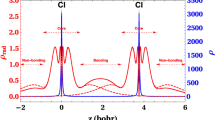Abstract
We define the densities of atoms in molecules so that their Bregman divergence from reference proatom densities is minimized. This generalizes the information-theoretic approach to atoms in molecules and under reasonable assumptions, results in a formulation that resembles the Hirshfeld partitioning. In general, Bregman partitionings are intrinsically nonlocal, and this means that this formulation, while mathematically elegant, is computationally unwieldy.
Similar content being viewed by others
Notes
This is more than is required, mathematically. The following analysis will hold for any twice-integrable function.
References
Ayers PW (2000) Atoms in molecules, an axiomatic approach. I. Maximum transferability. J Chem Phys 113:10886–10898
Fias S, Heidar-Zadeh F, Ayers PW, Parr RG (2017) A reference-free stockholder partitioning method based on the force on electrons (submitted)
Nalewajski RF, Parr RG (2000) Information theory, atoms in molecules, and molecular similarity. Proc Natl Acad Sci 97:8879–8882
Nalewajski RF, Parr RG (2001) Information theory thermodynamics of molecules and their Hirshfeld fragments. J Phys Chem A 105:7391–7400
Parr RG, Ayers PW, Nalewajski RF (2005) What is an atom in a molecule? J Phys Chem A 109:3957–3959
Ayers PW (2006) Information theory, the shape function, and the Hirshfeld atom. Theor Chem Acc 115:370–378
Heidar-Zadeh F, Ayers PW, Vöhringer-Martinez E (2017) Constrained iterative Hirshfeld charges: a variational approch (submitted)
Hirshfeld FL (1977) Bonded-atom fragments for describing molecular charge densities. Theor Chim Acta 44:129–138
Verstraelen T, Vandenbrande S, Heidar-Zadeh F, Vanduyfhuys L, Van Speybroeck V, Waroquier M, Ayers PW (2016) Minimal basis iterative stockholder: atoms in molecules for force-field development. J Chem Theory Comput 12:3894–3912
Bultinck P, Ayers PW, Fias S, Tiels K, Van Alsenoy C (2007) Uniqueness and basis set dependence of iterative Hirshfeld charges. Chem Phys Lett 444:205–208
Verstraelen T, Ayers PW, Van Speybroeck V, Waroquier M (2013) Hirshfeld-E partitioning: AIM charges with an improved trade-off between robustness and accurate electrostatics. J Chem Theory Comput 9:2221–2225
Verstraelen T, Ayers PW, Van Speybroeck V, Waroquier M (2014) Extended Hirshfeld: atomic charges that combine accurate electrostatics with transferability. Abstr Pap Am Chem Soc 247:1
Ghillemijn D, Bultinck P, Van Neck D, Ayers PW (2011) A self-consistent Hirshfeld method for the atom in the molecule based on minimization of information loss. J Comput Chem 32:1561–1567
Manz TA, Sholl DS (2010) Chemically meaningful atomic charges that reproduce the electrostatic potential in periodic and nonperiodic materials. J Chem Theory Comput 6:2455–2468
Manz TA, Sholl DS (2012) Improved atoms-in-molecule charge partitioning functional for simultaneously reproducing the electrostatic potential and chemical states in periodic and nonperiodic materials. J Chem Theory Comput 8:2844–2867
Lillestolen TC, Wheatley RJ (2009) Atomic charge densities generated using an iterative stockholder procedure. J Chem Phys 131:144101
Lillestolen TC, Wheatley RJ (2008) Redefining the atom: atomic charge densities produced by an iterative stockholder approach. Chem Commun 45:5909–5911
Verstraelen T, Ayers PW, Van Speybroeck V, Waroquier M (2012) The conformational sensitivity of iterative stockholder partitioning schemes. Chem Phys Lett 545:138–143
Heidar-Zadeh F, Ayers PW (2015) How pervasive is the Hirshfeld partitioning? J Chem Phys 142:044107
Heidar-Zadeh F, Ayers PW, Bultinck P (2014) Deriving the Hirshfeld partitioning using distance metrics. J Chem Phys 141:094103
Heidar-Zadeh F, Vinogradov I, Ayers PW (2017) Hirshfeld partitioning from non-extensive entropies. Theor Chem Acc 136:54
Nielsen F, Nock R (2011) On the Reyni and Tsallis entropies and divergences for exponential families, arxiv
Zhang J (2004) Divergence function, duality, and convex analysis. Neural Comput 16:159–195
Fujisawa H, Eguchi S (2008) Robust parameter estimation with a small bias against heavy contamination. Journal of Multivariate Analysis 99:2053–2081
Cichocki A, Amari S (2010) Families of alpha-beta-and gamma-divergences: flexible and robust measures of similarities. Entropy 12:1532–1568
Nielsen F, Nock R (2009) Sided and symmetrized Bregman centroids. IEEE Trans Inf Theory 55:2882–2904
Boissonnat JD, Nielsen F, Nock R (2010) Bregman Voronoi Diagrams. Discret Comput Geom 44:281–307
Heidar-Zadeh F, Ayers PW, Bultinck P, Verstraelen T (in preparation)
Zhu HY, Rohwer R (1995) Bayesian invariant measurements of generalization. Neural Process Lett 2:28–31
Skilling J (1989) Classic maximum entropy. In: Skilling J (ed) Maximum entropy and Bayesian methods. Springer, Cambridge, pp 45–52
Skilling J (1988) The axioms of maximum entropy. In: Erickson GJ, Smith CR (eds) Maximum entropy and Bayesian methods in science and engineering. I. Foundations, Springer, Cambridge, pp 173–187
Ayers PW, Anderson JSM, Bartolotti LJ (2005) Perturbative perspectives on the chemical reaction prediction problem. Int J Quantum Chem 101:520–534
van Leeuwen R, Baerends EJ (1995) Energy expressions in density-functional theory using line integrals. Phys Rev A 51:170–178
Acknowledgements
The authors thank NSERC and Compute Canada for funding. FHZ acknowledge support from Vanier-CGS fellowship and Ghent University Scholarship for a Joint Doctorate.
Author information
Authors and Affiliations
Corresponding authors
Rights and permissions
About this article
Cite this article
Heidar-Zadeh, F., Ayers, P.W. Fuzzy atoms in molecules from Bregman divergences. Theor Chem Acc 136, 92 (2017). https://doi.org/10.1007/s00214-017-2114-y
Received:
Accepted:
Published:
DOI: https://doi.org/10.1007/s00214-017-2114-y




